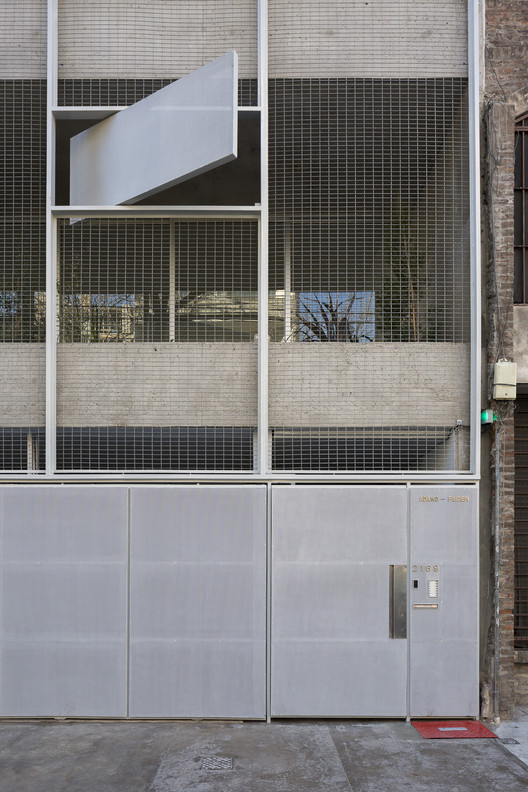Art and Architecture Faculty Inês Lobo Arquitectos + Ventura Trindade Arquitectos
2013-12-12 01:00
架构师提供的文本描述。1916-1970年最初的计划。建于1916年,Alentejo磨坊在20世纪70年代成为Le es面食厂。
Text description provided by the architects. 1916 - 1970 Original programme. Built in 1916, the Alentejo Milling Society became the Leões pasta factory in the 1970s.
© Leonardo Finotti
莱昂纳多·芬诺蒂


从距离历史中心很远的地方看,从老莱昂斯工厂的方向看,人们可以理解,奇怪的是,它的主要价值在于它的体积过大,突然强加在高原上。
Seen from a distance from the historic centre and the approach in direction of the old Leões factory allows one to understand that, oddly enough, its principle value consists of its excessive volume that is imposed abruptly on the plateau.
© Leonardo Finotti
莱昂纳多·芬诺蒂


建筑物是围绕着机器设计的,而不是围绕着人,不管是物理上的还是先验的,这些人被简化为机器中的操作者、工人和简单的齿轮。
Buildings designed around the machines they would house, and not around people, in physical or transcendental terms, who are reduced to mere operators, workers, simple cogs in the machine.
© Leonardo Finotti
莱昂纳多·芬诺蒂


2006-2009年新方案:艺术大学视觉艺术系和建筑系
2006 – 2009 New programme. University of the arts, department of visual arts and department of architecture
© Leonardo Finotti
莱昂纳多·芬诺蒂


由人占有的部分占用但没有机器的建筑物。空间,由于其多才多艺和与领土的关系,成为教学场所。
A partially occupied but machine-less building, appropriated by man. Spaces that, due to their versatility and relationship with the territory, became places for teaching.
© Leonardo Finotti
莱昂纳多·芬诺蒂


不属于原建筑一部分的附件以及建筑物内的所有临时建筑都被移除。这些建筑的空间性质变得清晰起来。
The annexes that were not part of the original construction were removed, as were all provisional construction inside the building. The spatial nature of the buildings became clear.
© Leonardo Finotti
莱昂纳多·芬诺蒂


增加了一座建筑,取代了附属建筑,从而重新配置了庭院,有了相关的车间、自助餐厅和倾斜的建筑。
A building is added that substitutes the annexes, thus configuring the courtyard afresh, with associated workshops, a cafeteria and a lean-to.
© Leonardo Finotti
莱昂纳多·芬诺蒂


在现有空间中增加了其他基础设施,为教学提供必要的设施和额外的家具。
Other infrastructures were added to the existing spaces, which provide the necessary facilities for teaching, and extra furniture.
© Leonardo Finotti
莱昂纳多·芬诺蒂


随着对旧工业空间和系统的了解的增加,我们发现了一些在学校建设中重用的策略。
With increasing knowledge of old industrial spaces and systems we find some of the strategies to reuse in the construction of the schools.
© Leonardo Finotti
莱昂纳多·芬诺蒂


首先是保护铁路站台和其他装卸区域的大型覆盖物,它们的细腻轻盈程度几乎无法与庞大的建筑物形成鲜明的对比。
First are the large coverings that protected the railway platform and other loading and unloading areas, which could hardly contrast more in their delicate lightness with the enormous mass of the constructions.
© Leonardo Finotti
莱昂纳多·芬诺蒂


现在重新介绍,它代替了产品和原材料,为教师和学生提供了庇护,建造了学校合奏的聚会场所,勾勒出了在合奏的所有空间之间建立视觉关系的主要露台,它的中心空地是一个令人意想不到的绿野,让人想起了大学校园,在此之前,我们的身体在构建学校空间的同时,把不同的元素连接在一起,这是一种巨大而细长的中庭,是一种脊梁,让先前被隔离的身体再次发挥作用,成为单一结构的一部分。
Now re-introduced, it shelters teachers and students instead of products and raw materials, constructing the meeting place of the school ensemble, it outlines the main patio establishing a visual relationship between all the spaces of the ensemble, whose central open space is an unexpected green field which is reminiscent of university campuses, until then so distant from this context. This body connects the different elements at the same time as it constructs the School space, a large and elongated atrium, a kind of backbone that allows bodies that were previously isolated to function once more, becoming part of a single structure.
















































































































































Architects Inês Lobo Arquitectos, Ventura Trindade Arquitectos
Location Evora, Portugal
Category University
Architect in Charge Inês Lobo Arquitectos
Area 10000.0 sqm
Project Year 2009
Photographs Leonardo Finotti
























